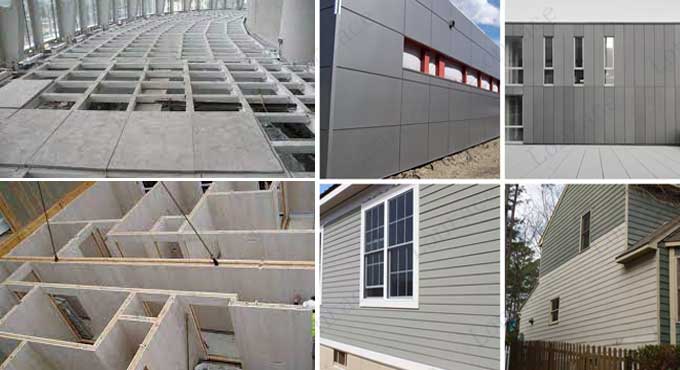
Fiber Cement: Everything you need to know

It's not always necessary for house elevations to be repetitive and comparable. Each house's exterior may be altered much like the interior.
With the employment of components like pointing, texture, siding, cladding, and other similar ones, the outside of the house may be given an intriguing twist.
Fiber Cement Board and other most recent-generation engineered materials have, however, quickly developed as a new alternative to this, with the same and in some cases, even superior look. This is due to advances, trials, and inventive uses.
In the early 1980s, James Hardie, a famous builder from the east coast of the United States produced a versatile building material called fiber cement, or fiber reinforced cement (FRC). As the name suggests, fiber cement is a composite material that is made by combining cement with cellulose fibers for strengthening.
The fiber cement products are made from a combination of the following products:-
1. Cellulose fiber acts as filler in the mixture.
2. Portland cement mixture is used as a binding ingredient.
3. Sand to maintain its durability in almost every weathers.
4. Water to harden the concrete mixture.
It is also possible to add a small number of other chemical additives to enhance the process, or to provide a particular structure with certain characteristics.
Properties of Fiber Cement
Below are some of the well-known properties of this fiber concrete:-
1. Fiber cement is a non-combustible construction material since it doesn't burn.
2. Building materials made of fiber cement are water resistant and do not sustain persistent water damage.
3. It is durable, UV-resistant, and impervious to rotting and warping.
List of Specialized sets of tools for Fiber Concrete
For the ease of working with fiber cement products, James Hardie has developed a specialized set of tools:-
1. Cladding installation may be completed easily by one person thanks to a clamp that holds the plank during installation.
2. Fast and precise hand tool made specifically for cutting plank cladding.
3. These fiber cement materials are cut using circular blades that are specifically engineered to generate extremely little dust.
4. To improve strength while attaching cladding, use a clip.
5. For flawless and accurate straight cuts on any cement board, use a simple yet efficient hand tool.
6. Screws made to suit all cement boards.
Can fiber cement building products be used for any purpose?
The characteristics of fiber cement make it ideally suited for the following purposes:-
Wood siding made from fiber cement
The use of wood as a siding material is considered to be a characteristic choice. One of the many varieties of roof coverings is shingles, while the other is clapboards.
Sidings made from the wood of many types can be found on the market today. Sidings are made from pine trees, spruce trees, and cedar trees.
Benefits
1. If kept correctly, wood sliding is durable and might endure for several decades.
2. If the expense of installation and higher grades are excluded, it is quite cost-effective.
3. To offer innovative options for exterior surfaces, wood siding may be altered to take on specific sizes and arrangements, colors, and designs.
Fiber Cement Siding is available in a wide range of colors and can even be decorated with wallpaper for a nice look. As upkeep is inexpensive, the initial expenditures associated with their installation may also be handled over time.
Siding made of fiber cement boards
Fiber cement, a development in the field of building supplies, is made from wood fiber, cement, sand, and clay. Fiber Cement Board Siding's sole disadvantages are its high initial cost and labor-intensive installation.
Apart from this, fiber cement has a tone of benefits and can be made to appear exactly like wood cladding on external walls.
Benefits
1. Cement Fiber Board In contrast to wood; which is extremely vulnerable to fire damage, siding is a fire-resistant material.
2. Also resistant to UV rays, fungi, termites, and insects, the material greatly decreases the need for onerous care.
3. Since they are made from leftover wood fibers, fiber cement boards are a sustainable alternative to wood siding.
To learn more, watch the following video tutorial.
Video Source: Anime_Edu - Civil Engineering Videos
The siding can have veneers and laminates applied to give it a desirable wood-like look, but with the extra strength and durability of laminates. Your options still include using glue to patch things or digital printing.
As a result, fiber cement siding has become a viable alternative to wood panels in architectural design that is both affordable and environmentally beneficial. For their walls, Fibre Cement Siding is offered in a number of finishes, including glossy, painted, and automotive options.
Wrapping it up
Moreover, Fiber Concrete boards are rapidly gaining favor in interior design, particularly in kitchens and walls where health is a key factor.
Fiber Cement Board Siding is being dealt with and promoted on a brand-new platform by a number of leading domestic and foreign industries.


